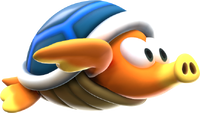Snortoise
| Snortoise | |
|---|---|
 Rendered model | |
| Appears in | Super Mario Bros. Wonder (2023) |
| Variant of | Koopa Troopa |
Snortoises[1] are pig-nosed turtle-like enemies in Super Mario Bros. Wonder. They have orange skin and a long snout. Their navy blue shell resembles that of a Koopa Troopa, though it is flatter, its head and arm holes are combined into one, and the lines between each scute are a lighter blue instead of black. They function as variants of Red Koopa Troopas, moving back and forth, turning on ledges, walls, and the edge of Downpour Cloud waterfalls, and hiding into their shell when stomped. When outside of water, they simply crawl back and forth on the ground, but they will swim at a constant elevation when underwater.
They first appear in Robbird Cove and later return in Downpour Uproar. Their shells can be used in both courses to break Brick Blocks underwater and swim through currents, granting access to various 10-flower coins.
Gallery[edit]
Naming[edit]
"Snortoise" is a portmanteau of "snorkel" or "snort" (in reference to their pig-like snout) and "tortoise". Their internal file designation suggests they were originally going to more closely resemble sea turtles.
Internal names[edit]
| Game | File | Name | Meaning
|
|---|---|---|---|
| Super Mario Bros. Wonder | G:/romfs/Model/EnemyUminoko.bfres.zs | Uminoko | Portmanteau of「海」(umi, sea) and「ノコノコ」(Nokonoko, Koopa Troopa), as well as a pun on「海の子」(umi no ko, child of the sea) |
| Super Mario Bros. Wonder | G:/romfs/Pack/Actor/EnemyNokonokoSea.pack.zs | NokonokoSea | Sea Koopa Troopa |
Names in other languages[edit]
| Language | Name | Meaning | Notes |
|---|---|---|---|
| Japanese | スッポコ[1] Suppoko |
Portmanteau of「 |
|
| Chinese (traditional) | 鱉鱉[2] Biēbiē |
Repeated form of「鱉」(biē, "softshell turtle") | |
| Korean | 자랑[3] Jarang |
Rough homophone between "자라" (jara, "softshell turtle") and " |
References[edit]
- ^ a b (January 26, 2024). マリオたちの行く手を阻む。フラワー王国の個性豊かな敵キャラクターをご紹介。~その1~【ワンダーの世界へ Vol.13】. nintendo.co.jp. Retrieved January 26, 2024.
- ^ February 23, 2024. 阻擋瑪利歐一行人的去路。將為您介紹花花王國充滿個人特色的敵方角色。~第一篇~【前往驚奇的世界 Vol.13】. nintendo.com.hk. Retrieved February 23, 2024.
- ^ February 8, 2024. 마리오와 친구들을 방해한다. 플라워 왕국에서 만날 수 있는 개성 넘치는 적 캐릭터를 소개. ~제1편~【원더의 세계로 Vol.13】. nintendo.co.kr. Retrieved February 13, 2024.

